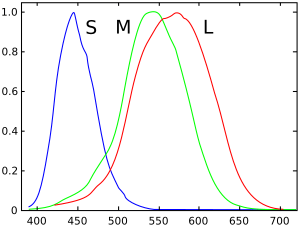Cone cell facts for kids
Cone cells or simply cones are special photoreceptor cells in the retina. They react to light and work best in relatively bright light.
Cone cells are less sensitive to light than rod cells. Rod cells are more sensitive, but cannot tell colors apart. Human eyes usually have three different types of cone cells. That allows the brain to tell colors apart. Their reaction to stimuli is faster than that of the rod cells. For this reason, they can perceive finer details, and more rapid changes in images.
The three kinds of human cones have different photopsins. Each photopsin has a different response curve to light, and so responds to color in different ways. This gives trichromatic vision. Being color blind means a lack of one or two types of cone cells.
In a publication done in 1935, Osterberg thinks that there are about 6 million cone cells in a human eye.
Images for kids
See also
 In Spanish: Cono (célula) para niños
In Spanish: Cono (célula) para niños



